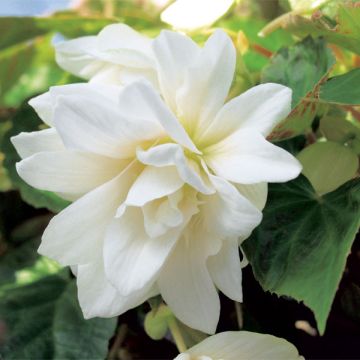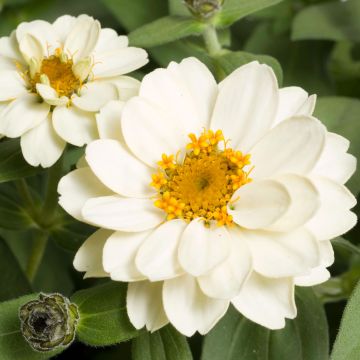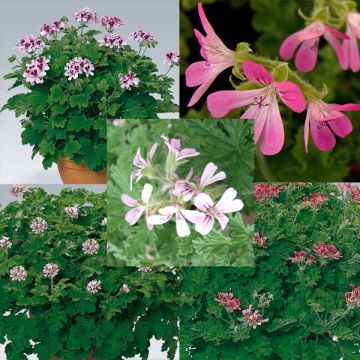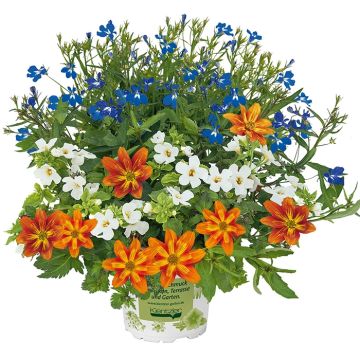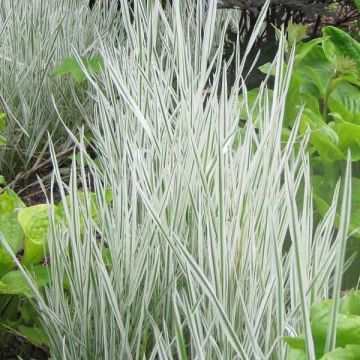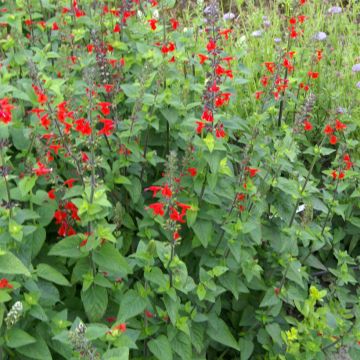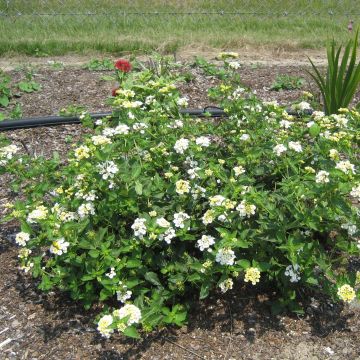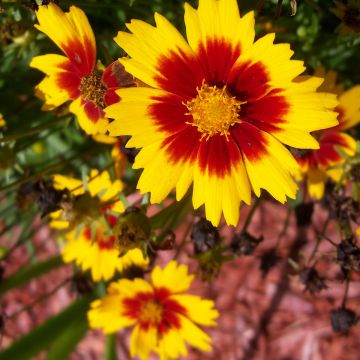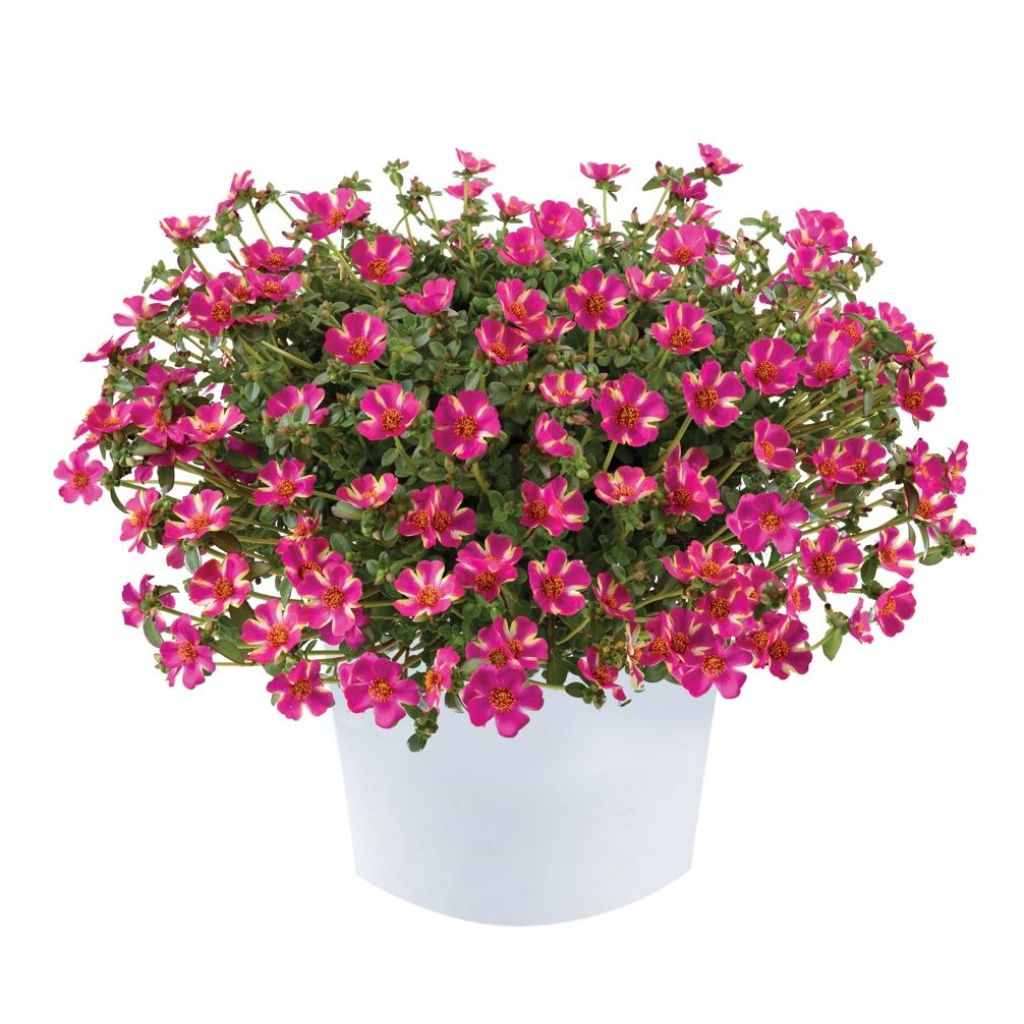

Portulaca oleracea Campino Twist Pink - Purslane
Portulaca oleracea Campino Twist Pink - Purslane
Portulaca oleracea Campino Twist Pink
Purslane, Little Hogweed
This item cannot be shipped to the selected country
Delivery charge from €5.90
More information
Schedule delivery date,
and select date in basket
This plant carries a 6 months recovery warranty
More information
We guarantee the quality of our plants for a full growing cycle, and will replace at our expense any plant that fails to recover under normal climatic and planting conditions.
From €5.90 for pickup delivery and €6.90 for home delivery
Express home delivery from €8.90.
Does this plant fit my garden?
Set up your Plantfit profile →
Description
The Portulaca 'Campino Twist Pink' is an annual Purslane that forms a pretty dense clump, with a harmonious habit, covered in small brilliantly bicolored flowers from spring until the end of summer. A small plant with succulent foliage, drought-resistant, it thrives in any well-drained soil, even poor, and only requires sunshine to flourish. This early and floriferous variety, with bright pink flowers striped with pale yellow to white, is perfect for enlivening summer compositions, as well as sunny borders and rockeries.
The Portulaca oleracea 'Campino Twist Pink' belongs to the Portulaca family. Its ancestor, the garden Purslane, is a very common herbaceous annual plant in gardens, especially in hot places and degraded or very compact soil, particularly dry in summer. It is found particularly in the South of France and throughout the Mediterranean basin. The varieties in the 'Campino' series have been selected for their early and prolonged flowering, their original bicolored flowers, as well as their bushy, ramified and harmonious habit.
This 'Twist Pink' Portulaca quickly forms a small dense clump, measuring about 25 cm (10in) in height and 35 cm (14in) in width. The green stems bear small elongated, lanceolate and fleshy leaves, of a bright green hue. The flowering is renewed from May until September. The 2-3 cm (1in) diameter flowers are composed of crumpled silk-like petals. Their colour is a very bright pink, with two pale yellow-tinged white lines on each side. The heart of the flower, red in colour, is occupied by a bouquet of golden yellow stamens. A sunny exposure is required for the corollas to fully open.
Plant the 'Campino Twist Pink' Purslane in rockeries, borders, hanging baskets or pots, alone or in combination with other annual flowers. In large masses or in small accents, this plant, so undemanding and cheerful, will enliven any sunny corner, without requiring much attention. This dense and semi-creeping plant is a good ground cover, to be installed in borders and flower beds in the company of dryland plants, such as dwarf wormwoods, love-in-a-mist, thyme, California poppies, and sedums, for example.
Note: Please be aware that our young plug plants are professional products reserved for experienced gardeners: upon receipt, repot and store them under cover (veranda, greenhouse, cold frame) at a temperature above 14°C (57.2°F) for a few weeks before being installed outdoors once the risk of frost is definitively eliminated.
Report an error about the product description
Flowering
Foliage
Plant habit
Botanical data
Portulaca
oleracea
Campino Twist Pink
Portulacaceae (Montiaceae)
Purslane, Little Hogweed
Cultivar or hybrid
Other Annuals A to Z
Planting and care
Planting period
Intended location
Care
This item has not been reviewed yet - be the first to leave a review about it.
Plug plants - Annuals
Haven't found what you were looking for?
Hardiness is the lowest winter temperature a plant can endure without suffering serious damage or even dying. However, hardiness is affected by location (a sheltered area, such as a patio), protection (winter cover) and soil type (hardiness is improved by well-drained soil).

Photo Sharing Terms & Conditions
In order to encourage gardeners to interact and share their experiences, Promesse de fleurs offers various media enabling content to be uploaded onto its Site - in particular via the ‘Photo sharing’ module.
The User agrees to refrain from:
- Posting any content that is illegal, prejudicial, insulting, racist, inciteful to hatred, revisionist, contrary to public decency, that infringes on privacy or on the privacy rights of third parties, in particular the publicity rights of persons and goods, intellectual property rights, or the right to privacy.
- Submitting content on behalf of a third party;
- Impersonate the identity of a third party and/or publish any personal information about a third party;
In general, the User undertakes to refrain from any unethical behaviour.
All Content (in particular text, comments, files, images, photos, videos, creative works, etc.), which may be subject to property or intellectual property rights, image or other private rights, shall remain the property of the User, subject to the limited rights granted by the terms of the licence granted by Promesse de fleurs as stated below. Users are at liberty to publish or not to publish such Content on the Site, notably via the ‘Photo Sharing’ facility, and accept that this Content shall be made public and freely accessible, notably on the Internet.
Users further acknowledge, undertake to have ,and guarantee that they hold all necessary rights and permissions to publish such material on the Site, in particular with regard to the legislation in force pertaining to any privacy, property, intellectual property, image, or contractual rights, or rights of any other nature. By publishing such Content on the Site, Users acknowledge accepting full liability as publishers of the Content within the meaning of the law, and grant Promesse de fleurs, free of charge, an inclusive, worldwide licence for the said Content for the entire duration of its publication, including all reproduction, representation, up/downloading, displaying, performing, transmission, and storage rights.
Users also grant permission for their name to be linked to the Content and accept that this link may not always be made available.
By engaging in posting material, Users consent to their Content becoming automatically accessible on the Internet, in particular on other sites and/or blogs and/or web pages of the Promesse de fleurs site, including in particular social pages and the Promesse de fleurs catalogue.
Users may secure the removal of entrusted content free of charge by issuing a simple request via our contact form.






































